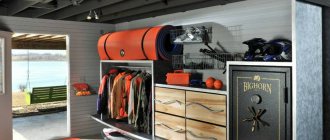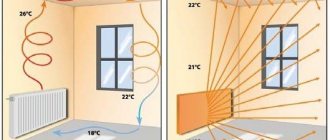Infrared (IR) heaters, so popular today, are fairly simple devices.
However, those wishing to install infrared heating in a private home are faced with a number of important issues. Is it possible to use such devices as the main heating?
What type and power of IR heater would be most suitable? Is this device capable of causing harm to human health? These and other white spots in the characteristics of IR heaters will be eliminated in the material below.
Nature of IR radiation
Infrared is called electromagnetic radiation with a wavelength from 0.76 microns to 1 mm. This range lies between visible red light and microwave radiation. Infrared radiation is not detected by our eyes, but we can feel it tactilely because it carries thermal energy. It is on this feature that the operation of the IR heater is based.
Range of infrared radiation in the general spectrum of electromagnetic radiation
IR waves can be considered the most common radiation. They are generated by any object that has a temperature above absolute zero. With increasing temperature, the intensity and frequency of radiation increase, and these parameters also depend on the material of the emitter. In modern IR heaters, materials such as carbon, tungsten, ceramics, quartz, etc. are heated to generate radiant heat.
Operating principle
Infrared heaters differ from convective heaters in their operating principle - they do not heat the surrounding air mass, the radiation heats objects in the area of operation of the unit. And the already heated floor, walls and furniture release heat into the air. Since solid bodies shield the waves emitted by the heater, the floor under the table in their path will not warm up, but the heated table itself will release the resulting heat in all directions. Although comparing infrared heaters with the sun is more of a marketing ploy, their radiation spectrum characteristics are similar.
Advantages and disadvantages of technology
Devices of this group have a number of advantages:
- Directional heat transfer. The main advantage of infrared heating lies, first of all, in heating the object itself, while traditional convectors and radiators do this through a very inconvenient intermediary - air. The inconvenience lies in the tendency of warm air to evaporate to the ceiling, while the people for whom the heat is generated, by a strange whim of nature, live in the lower part of the room. In the case of IR heaters, such oddities are not observed: first, thermal energy is transferred to people, animals and objects, and only then the air is heated from them.
- Economical. This advantage follows from the previous one: due to targeted heat transfer, heat loss is significantly reduced, so IR heating can save up to 50% of costs.
- Low inertia. The heat from an IR heater is felt within half a minute after it is turned on, while a convector will first have to warm up all the air in the room, which does not mix so quickly during natural circulation (due to convection). If a person stays indoors periodically and for a short time, for example, in a garage, the benefits of using infrared heating increase several times.
- Effective work in rooms with large volumes , increased ventilation and even outdoors. Creating a comfortable microclimate using infrared heating convectors or a radiator in a large warehouse, in a large pavilion, in a store with high traffic or at a welding station will require huge costs. In an open area, these devices will be completely powerless. But IR heating will cope with the task with a bang.
- Space saving. Since the operating principle of IR devices is not related to convection, they can be located right under the ceiling, leaving the space on the floor completely free. In addition, some types of such devices are so thin that their presence can only be detected by the emanating heat.
Here are the arguments opponents of this technology give:
- High operating cost. Electric heating, as you know, is much more expensive than gas or centralized heating.
- Limited exposure. Heat from the IR heater will only be received by those objects that are in its radiation field. But even here the comfort zone is not so extensive: as you move away from the device it becomes noticeably cooler, and if you get closer, on the contrary, it becomes hot. It should also be mentioned that such emitters affect objects only from one side, which can sometimes be inconvenient.
- IR waves can be harsh on human skin.
Eco-friendly, silent and efficient infrared heating is increasingly used in private homes. But probably not everyone knows that infrared rays can negatively affect health, especially if the system is installed incorrectly. Harm from an infrared heater: is radiation really dangerous for humans?
Read about how to organize heating of a room without wood or gas.
In addition to all the already familiar heating radiators, many people prefer to install heated floors. You can connect the heated floor yourself. You will learn how to do this in this material https://microklimat.pro/sistemy-otopleniya/montazh-sistem-otopleniya/sxema-podklyucheniya-teplogo-pola.html. Features of connection in a private house and apartment.
Best models
Various manufacturers in Europe and Russia produce home heating equipment. In this rating of infrared heaters, the best models that have collected positive customer reviews are selected.
1st place - Ballu BIH-AP4-0.8-W
The cost of this model is around 3000 rubles. This heater is designed to heat an area of 16 square meters, connects to a 220/230 V system and is installed at a recommended height of 2.4–3.5 meters, its power is 800 W.
Based on reviews, we find out that this is an effective and high-quality model that warms up the room quickly enough. The set includes durable brackets - with their help the device can be rotated. This model is mainly used as an additional source of heating in any room, but is also suitable for a garage and for installation outdoors - the waterproof housing will not allow rain to spoil it.
2nd place - Almac IK5
This infrared heating battery has a lower power of 500 W. It effectively heats 10 square meters, so in a single copy it is used as an additional heat source. However, three similar models can easily cope with heating a large living room or hall.
Judging by the reviews, the device effectively copes with its task, is easily attached to the wall or suspended from the ceiling, and is simply adjustable - it is enough to set 23 degrees during the day, 20 at night. The only drawback is the complexity of the connection. And although the instructions indicate how to install an infrared heater, the kit does not include wires and a thermostat, so without the appropriate knowledge and experience you cannot connect it - you will have to call a specialist, but you can turn a blind eye to this, given the low price of around 2,500 rubles.
3rd place - Peony Thermo Glass P-10 (7000 rubles)
The model is from the Russian one, which has become popular on the Russian market. Power – 1000 W, heating area – 20 m². The device is connected via a regular 220/230 V socket and is equipped with electronic control and a thermostat, which allows you to accurately regulate the power and heating temperature. It also received protection against overheating, which ensures minimal safety and increases its service life. The infrared heater can be installed on the ceiling at a height of 2.3–3.5 meters.
According to reviews, the model is effective: it quickly heats surrounding objects, operates silently and provides soft and pleasant warmth. This is an advantage, since some models heat aggressively.
The disadvantage is the equipment and high price. The model is significantly more expensive than similar heaters, and the kit does not include any cables. The device also needs to be looked after - if you do not systematically wipe the dust off it, then over time a burning smell will appear.
There are also many low-quality products on the market with the CE mark. In one case it means “Conformite Europeenne”, in the other it means “China Export”. Try to choose reliable equipment, since heating devices in the house always pose a certain danger.
Varieties
It is most convenient to classify infrared heating devices according to their installation location.
Ceiling
Infrared ceiling heating is the most common, since the ceiling at a height of up to 3 m is the optimal place to install an IR source.
Most ceiling models are of the lamp type.
Their emitters are made in the form of a cylinder or plate, and the device itself has an elongated shape and resembles a fluorescent lamp.
You can fix the “heating pad” on brackets, but the most popular type of fastening is a suspension in the form of a chain, the length of which can be independently adjusted.
In addition to a lamp heater, you can place a film IR heater on the ceiling. This truly revolutionary invention consists of two layers of polymer film, between which there are tracks of carbon paste. It plays the role of an IR emitter. The heater itself has the form of a thin sheet, which is laid on the ceiling and screwed with dowels or self-tapping screws.
Wall mounted
Devices in this series can not only heat a room, but also aesthetically enliven its interior.
They are made using film technology (infrared film for heating), with a colorful pattern applied to their outer layer.
Such picture heaters have become very popular recently.
Floor-standing
Special models of IR film, equipped with a self-adhesive base, are designed for laying on the floor. After installation, the finishing floor covering is laid on top of the heater.
Infrared heated floor
Those wishing to install a wall-mounted picture heater should take into account that the surface of the device heats up quite strongly. If there are small children or animals in the house, the device should be installed so that they cannot touch it.
Scope of application
It can effectively cope with the function of the main heat source only in regions with a mild climate or when it is not very cold outside. Otherwise, it will be effective only as temporary, local or emergency heating.
It is worthwhile to dwell separately on local heating. IP allows you to set individual thermal conditions in different areas of the same room. If circumstances so require, the system can be partially disabled.
The scope of their application extends beyond residential or public premises. They are successfully installed in any place where it is difficult to install central heating, for example, garages, greenhouses or sheds.
12 volt infrared film helps to safely heat places where it is not recommended to install an infrared system with a voltage of 220 V: from car seats to the bathroom floor or a rug for a four-legged pet.
Installation
Each conscientious manufacturer completes its product with detailed instructions, which indicate:
- minimum permissible diameter and number of fasteners;
- brand of wire that should be used to connect the device to the network (for example, PVA 3x1.5);
- minimum installation height (depending on power).
All instructions given must be followed with the utmost precision.
Before installing infrared heating, especially if it will include several devices, you should make sure that the wiring in the house can withstand such a load.
Often, IR heaters are connected through a thermostat, which turns off the device when the set room temperature is reached. This element should be installed in a place so that it is not exposed to sunlight or radiation from the heater.
When installing a film heater on the ceiling, the fasteners should be screwed into special tracks that do not contain carbon “filling”.
The effectiveness of IR floor films will depend on the type of finishing coating. Ceramic tiles provide the best heat transfer; laminate tiles are slightly inferior to them. Linoleum and carpet have the lowest thermal conductivity. You should also avoid carpeted floors.
Connection diagram for infrared heated floor
The floor film heater should be installed in an area free of furniture.
It is necessary to take into account that inexpensive models of film heaters do not contain a foil layer that acts as a reflector. In this case, the foil must be purchased separately and placed under the IR film, otherwise a significant portion of the heat will go into the building structures.
If you are afraid of drilling a wire laid in the wall, use a special detector. This device scans the thickness of any material and if it detects metal elements or live wiring, it issues a warning signal.
Minuses
This equipment has not only positive qualities. There are also disadvantages:
- Spot action of the heater. If it works in one place, then the heat will be there; in other parts of the room the temperature is lower.
- Taking into account the fact that the rays of the heater pass through the air and warm the furniture and things that they fall on, it is possible that a plastic smell may appear. This is possible if the heater is directed at the chair on which the TV remote control is lying.
- Aesthetics suffer in some cases. Portable or even film heaters do not always fit aesthetically into the interior.
- High price of the equipment itself.
Considering how much an infrared heater consumes (depending on the power, consumption reaches 0.5–1.5 kWh or 50–200 Wh/m²), it cannot be called energy efficient. In terms of energy consumption, these devices are almost no different from conventional oil radiators or convectors. Efficiency can be achieved by insulating the room and installing heat-reflecting screens, but this is also possible with conventional radiators.
The influence of infrared radiation on human health
Is infrared heating harmful to health? Excessive infrared radiation can lead to undesirable consequences.
Scientists studying the working conditions of steelworkers and glass industry workers even classified it as a negative factor.
First of all, thoughtless use of an IR emitter can lead to dry skin and burns.
High-intensity radiation (175 W/sq. m) provokes protein denaturation and disturbances at the cellular level. Visitors to infrared saunas should be especially careful.
Much depends on the wavelength of infrared radiation: the shorter it is, the deeper it penetrates into the body. IR waves with a length of 0.76 to 1.5 microns are the most dangerous because they “deepen” under the skin by as much as 4 cm. Conscientious manufacturers provide a table in their passports that displays the distribution of thermal energy by wavelength. Regulatory data on the permissible intensity of infrared waves of various lengths can be found in SanPiN 2.2.4548-96.
In a children's room, it is better to direct the radiation of an IR heater at walls, floors or objects, and not at the child. Each heated surface will act as a radiator, providing a comfortable microclimate, while the risk to the baby’s health will be reduced to zero.
Conclusion
Infrared heating is a new product on the modern market with great potential. Despite the fact that this technology was invented at the beginning of the last century, it is only now that it is being actively used for heating rooms. In the construction of large facilities, such heating is simply irreplaceable, because it significantly saves energy, is convenient to install and use, and has a number of other advantages. It is safe to say that this is the technology of the future, since in the context of the desire to reduce energy consumption, infrared heating is a big and bold step towards the goal.
Request a call
On-line calculator
Infrared heating - owner reviews
In general, owners of IR heaters speak very positively about these devices.
There are a lot of comments, but there are almost no reports of discomfort or health problems.
If anyone complains, the complaints are mostly related to the heater being too low (it’s supposed to heat your head) or overheating in the infrared sauna.
Many, based on personal experience, advise installing not one powerful device, but several low-power ones in opposite points of the room. This ensures uniform distribution of thermal energy.
The topic of calculating the power of infrared heating in accordance with the area of the room, its shape and the number of external (cold) walls is being actively discussed. As experience shows, in a room of 18 square meters. m with one outer wall, two heaters with a power of 0.8 kW are capable of warming the air to a temperature of 22 - 24 degrees in two hours.
In a room of 24 sq. m with two external walls, two heaters with a power of 1.4 kW, contrary to the method proposed by the manufacturer, were not enough and the IR heating scheme had to be rearranged: two devices with a power of 1.1 kW were installed above the windows, and in the opposite corner - one heater with a power of 0.7 kW.
This option turned out to be optimal. In rooms with a narrow and long shape, the value of the required power, on the contrary, decreases. So, in an elongated room of 32 square meters. m with one window, to create comfortable conditions, two heaters with a total power of only 2.8 kW were required instead of the expected 4.16 kW.
With all its advantages, IR heating is considered by all users only as a support for water heating.
IR heaters are not always convenient, especially if you need to heat a small room - a balcony, a kiosk, a barn. Instead of a heater, in this case, an infrared lamp for heating the room is suitable, which has the same properties, but is less powerful.
Read about how to choose the right electric floor heating in this material.
Connection
It’s not hard to figure out how to connect an infrared heater - it operates on a 220-230 V network, so the simplest and most obvious way is to plug it into an outlet. At least, mobile models are connected to sockets.
Panels or film systems are connected to each other in parallel, then connected to the thermostat (control panel), after which the wire (phase, neutral and ground) is pulled directly to the machine located in the distribution panel. This allows you to bypass all the wiring brought into the apartment or house. Most often, a separate automatic machine is installed to heat the apartment, which is triggered when there is a heavy load or a short circuit. The rest of the wiring in the apartment is connected to another machine. This allows you to correctly distribute the loads generated during the operation of infrared heaters. If you “hang” a powerful heating system on the existing apartment wiring, then when the heating system and, for example, an electric oven, air conditioner or iron are operating simultaneously, overloads are possible. In rare cases, this leads to a fire, although most often automatic devices are triggered.
However, to create a cozy warm corner with a small number of panels with a total power of up to 2 kW, it is possible to connect an infrared heater to an outlet, that is, the general electrical wiring in the house.
General information about PLEN
PLEN – film radiant electric heater. In it, electrical energy is converted into infrared radiation, which heats the floor and, from it, the room. The system itself is multilayer, where there are non-conducting polymer films and resistors connected to each other.
This film is usually sold in rolls
When electrical energy passes through the resistors, they heat up and transfer heat to a highly conductive surface. It then transmits the received and converted thermal energy into infrared waves with a length of 9 to 12 microns. These rays heat another surface, which warms the room.
Home Guardian Angel
The wall heater adds warmth and coziness thanks to the image of a guardian angel.
Heating area - 15 sq.m, power 220 V, maximum heating -100 C. Can be used in an office, garage, loggia, apartment. Attached to the wall with screws.
Advantages:
- does not dry out the air;
- does not burn oxygen;
- decorates the room;
- creates heat;
- does not burn;
- can work around the clock;
- consumes little electricity.
Flaws:
- No.
Properties
The heater is produced in the form of a film material, available in rolls. Covering: plastic film. Thanks to the carbon ball and copper tires, heat transfer is 100%. The film heater can be designed as an additional, main heating system. The film is mounted on walls, ceilings, or hung on walls in the form of paintings or panels.
Used for heating production and storage areas, garages, sports grounds, baths.
Characteristics of film heater
Characteristics of an electric heater of film construction.
When choosing a film IR heater, you must be guided not only by its size - PLENs also have other characteristics, including those that are important for specific conditions:
- voltage of current consumption is mainly 220 V, but they are also produced at 110 V;
- power - up to 500 W, energy consumption per square meter of film heater (power density) can range from 70 to 170 W;
- maximum heating temperature – 35-50 degrees;
- current consumption – 0.7-1.2 A;
- specific gravity – up to 350 g/m2.
To make the description clearer, we summarize the data on the characteristics of film heaters in relation to their standard sizes:
*











